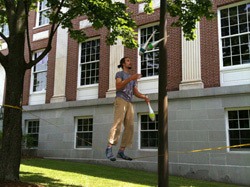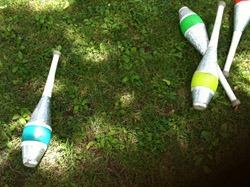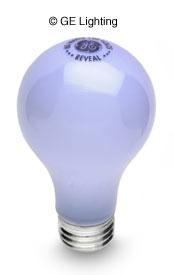Fabulous design. Cutting edge looks. Interesting twists in color, fabric, and texture. These are all elements inherent in design that's ecologically sound. Yes, your creativity can have free reign even as you make choices that help protect the planet. Increasingly, manufacturers are creating products that have minimal impact on the environment, whether because they're made from organically-grown cotton or because they're made with renewable resources. We think environmentally friendly design is so important that we recently added a Green Design lesson to the NYIAD Complete Course in Interior Design.
In our "Decorating Green" column we'll look at a sustainable, low-impact element of design in each issue of "Designer Monthly." We hope these articles will help us all help the planet and the many creatures that share it with us.
Farm-Fresh Design: finding home design ideas at the farmers’ market
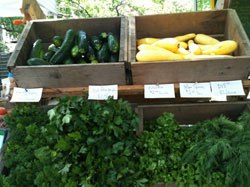
You could buy your groceries in a big, fluorescently-lit, super-air-conditioned grocery store, not knowing where the produce was grown, or how far it had to be trucked and flown in, or when it was plucked from the ground.
Or you could buy in an open-air market directly from the farmer who grew the produce, surrounded perhaps by musicians, the smell of fresh tamales cooking, or your neighbors bustling about.
In the past thirty or so years in most American cities and large towns, the farmers’ market has taken off as the place to buy locally grown produce, and the abundant displays of produce can be overwhelmingly beautiful: broccoli so deeply green it seems to be tinted purple, bright radishes big as your fist, heads of lettuce that seem the very definition of the word “fresh.”
One of the ideas pushing the popularity of the farmers’ market is the “locavore” movement: the belief that eating food produced close to you is better for the environment, better for your own health, and better for your local economy.
The less food that’s brought in by plane, train and truck, the less fuel is used. And the more food that’s grown locally, the more your grocery dollars go to support local farmers, who in turn can put more money into their local community. And what could be better for your health than eating produce that was picked that very morning?
This summer we visited one of the country’s oldest and busiest farmers’ markets, in Burlington, Vermont, which is celebrating its thirtieth anniversary this year. The market started with six vendors, and now has sixty-two, according to Chris Wagner, the manager of the Burlington Farmers’ Market Association.
Because the market runs along the edge of City Hall Park and down two sidewalks into the park, it’s difficult to make an exact count of the number of people who attend, but Wagner estimates 2,500 to 3,000 shoppers show up each Saturday.
Vermont is known as an agricultural state, and the agricultural abundance at the farmers’ market reflects that wealth.
But as is the case at many farmers’ markets, the summertime pleasures of buying fresh, local produce are supplemented by the pleasures of exploring the locally-made crafts, many of which are designed to make the home prettier, easier to work in, or both.
According to Wagner, the Burlington Farmers’ Market, like many, has a requirement that at least 50 percent of its vendors are produce vendors, with the remainder a mix of prepared food vendors and craftspeople.
But like many markets, the Burlington market is supplemented with craftspeople who register to sell their wares near the food vendors, and can therefore take advantage of the crowds of shoppers looking for a little diversion in addition to searching for fresh produce.
One of the craftspeople who immediately caught our eye was Jason Boyd of Elemental Impressions, who had set up his stand of handmade wooden cutting boards under the auspices of the Firehouse Gallery, which has an entrance onto the park. Despite the fact that he’s only been making cutting boards for the past six months, Boyd drew the eye of many passing customers.
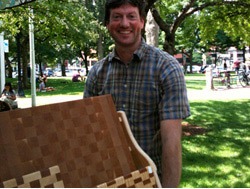
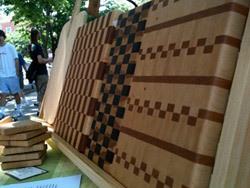
The cutting boards would lend a certain panache to any kitchen, with their modern striped or checker-board design. Because Boyd uses scrap wood, “every one ends up being different,” he said.
Shoppers looking for bowls for all that salad will find the ceramics created by Claude Lehman to fit the bill. Lehman’s wares are very appealing in their glossy blue glazes, just crying out to be filled with fresh green goodies.
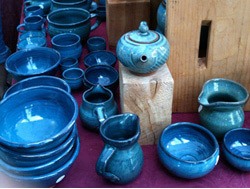
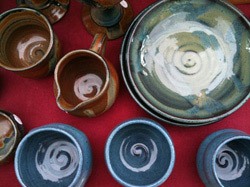
Since the farmers’ market is all about sustainability, it’s no surprise that one vendor is Recycle Moe, whose motto is “saving the world, one crafty idea at a time.”
One of Moe’s ideas we liked were these switch plates, which come in nearly any look you could imagine. We also liked the recycled use of these hard computer discs, refurbished here to become tiny notebooks, filled, of course, with recycled paper.
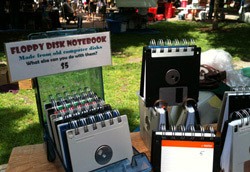
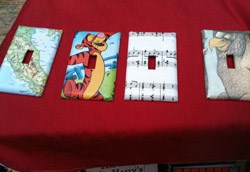
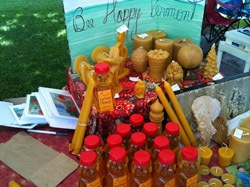
And what would a Vermont farmers’ market be without homemade beeswax candles? Bee Happy Vermont, run by Pedro Salas, offers honey and candles in a variety of shapes and sizes.
Just as we were leaving the market, we spotted a juggler balancing on a low tightrope strung between two trees. The juggler, who goes by the name Tony Briefcase, said he was just practicing, but once people start watching, “practice becomes performance.” Briefcase gathered a little crowd of on-lookers who cheered his teetering as they took a break from surveying the vast array of fresh, local bounty.
